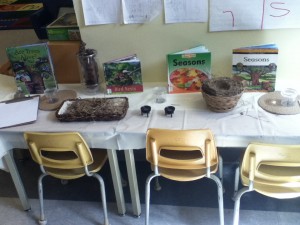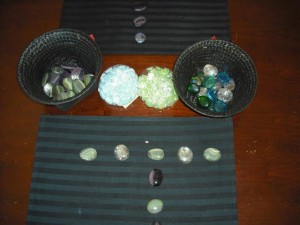 We are currently working on growth and change as an inquiry focus. I have selected materials that we have found in nature as well as some science items like worms, frogs, chicken embryos, and grasshoppers for the children to examine. We have studied some of them using our KWL chart—becoming researchers and looking in books, and on the internet to answer our “I wonder” questions. Through this learning process, children have been exposed to several types of non-fiction books (we compared fiction and non-fiction), learned how to journal their observations with adult support, and have drawn diagrams with labels. The materials are left for them to explore during our learning block of play. As children explore I will often place myself into the space to hear their conversations, to encourage them to record what they see, and to ask open-ended questions about their thoughts or to extend their learning. Next we will be adding our Butterflies to the collection!
We are currently working on growth and change as an inquiry focus. I have selected materials that we have found in nature as well as some science items like worms, frogs, chicken embryos, and grasshoppers for the children to examine. We have studied some of them using our KWL chart—becoming researchers and looking in books, and on the internet to answer our “I wonder” questions. Through this learning process, children have been exposed to several types of non-fiction books (we compared fiction and non-fiction), learned how to journal their observations with adult support, and have drawn diagrams with labels. The materials are left for them to explore during our learning block of play. As children explore I will often place myself into the space to hear their conversations, to encourage them to record what they see, and to ask open-ended questions about their thoughts or to extend their learning. Next we will be adding our Butterflies to the collection!
Focusing on the classroom environment is important in engaging students. It tells them what is valued, what is important in learning and it will certainly set a tone for learning. As I return to my classroom I am reflecting on what has worked and what hasn’t and other ways I can give students opportunities to learn new things.
For example, more computer access to seek information on our inquiry projects, adding mirrors to our light table area, looking at my shelving space and how I can organized various materials to make things more appealing to my students, and creating more centres of inquiry. With all this happening, how can I better assess my students through documentation. I created a new form that my ECE partner and I can track conversations in a more organized fashion and we can simply slip the forms into portfolios as opposed to always typing the information out. I also gathered more clipboards to have at each station and labelled these as our documentation boards.
Here are a few photos of centre idea where children can be creative.
This is a great little centre that focuses around found materials. Students can develop their fine motor skills in connection to math or art. The mats are earth tone in colour and are used as a different surface for children to create.
 This centre idea uses material found at the dollar store. There are jewels and stones of different colours that you can place in different baskets sorted by colour/shapes/size its up to you. You can use placemats, black felt, photo frames that students can use to display their different art pieces. Again, you can connect to math and a great oral language opportunity for the children.
This centre idea uses material found at the dollar store. There are jewels and stones of different colours that you can place in different baskets sorted by colour/shapes/size its up to you. You can use placemats, black felt, photo frames that students can use to display their different art pieces. Again, you can connect to math and a great oral language opportunity for the children.
Here are some pictures of one environment http://earlylearningcentral.ca/?page_id=2138 to get you thinking about your space. Reflective Questions: What do you do when the environment is not working for your students? How can you place materials that will engage student learning? How can I document student learning and display it?
Now that the you have had the opportunity to meet your students over the last little while, you can reflect on your daily schedule. Thinking it Through has a plan for both full and half days. http://earlylearningcentral.ca/?page_id=1218 . Some things can’t be changed due to the large schedules within your school, but you can always try to move things around if they are in the best interest of your students. Many schools are on the balanced day program with 3, 100 minute blocks of learning. I always ensure that my students get 60 minutes or more in one of those blocks, and a second block of about 45 minutes. The reason behind the time frames is to allow the children to explore the centre, select materials, create/manipulate, think and change, discuss, and share their learning without having to rush. They are learning how to learn!
During these next few weeks circulating the room with children would be a great opportunity to discuss with them what is available in each centre, behaviours, and routines. Remind them daily of what is available.
- Model the centre
- show what it looks like
- question for understanding
- have them model
- reteach where needed p. 10 Learning in Centres “Thinking it Through” http://earlylearningcentral.ca/wp-content/uploads/2009/02/TIT-aug-8.pdf
I personally do not designate where children should be nor do I have number limits. Children move freely to different centres as it sparks their interest. My ECE partner or myself will call children over to work in small groups during this block of play the other circulates, documenting and asking questions as they pertain to our goals or big ideas for the centre. All children are responsible for the entire room clean-up.
As a parent to a first time JK student, I found myself asking him question after question once he got home today. At first he answered I don’t know and later he shared more about his day.
As a teacher to new students in a new enviroment an idea would be to send home a little information about their first week. On a piece of paper create some simple sentences like; I played with ________, I played at the _______ centre. Then, let them illustrate a picture on their own about something they enjoyed. You can call them over in small groups, you can circulate around the room and engage in oral conversation while recording their ideas during play. When time allows you can take a photo and send it home . This way they can talk at home about things they actually did!
When thinking about your classroom organization for the students attending in the next few weeks, the Thinking it Through document -Learning Centres booklet starting on p.9 makes some great points to ponder when reflecting on your classroom set-up. http://earlylearningcentral.ca/wp-content/uploads/2012/08/TIT-aug-8.pdf
- The classroom should be warm and inviting to students, and the Reggio Emilia approach is to have the classroom serve as a “third teacher”.
- the environment reflects our values as teachers, and informs and shapes the kind of learning that will happen
- consider positioning of centres (loud vs quiet), flow
- include natural materials as much as possible-in my science centre I have pine cones, rocks, twigs, leaves just a few to start off and then the children will be responsible to help build this centre
- think about large and small groupings-tables in my classroom are incorporated into centres as well as for snack. This way they have a multi-purpose and it reduces the amount of large furniture. I also have no desk, but I have 2 filing cabinets one for my daybook and supplies and the other for files.
- p. 15-17 poses some reflective questions to consider in classroom set-up
- starting on p.32 some recommended learning centres are listed discussing there purpose, observation pts, material lists, furniture, and a suggestion for location.
In our classroom, my ECE partner and myself think about making it a “home like” environment where the walls have little commercial bought products, but picture frames handing where we will eventually display children’s art work. I purchased a few plants, we are going to add some lamps to create a cozy feeling in our reading corner, and last year we had some birch branches cemented into flower pots and strung with white Christmas lights to add that outdoor feel to our science centre. In the first few weeks we have just enough materials out, so that we can observe, establish routines in the classroom, get to know the children and their strengths, and to see what they need to develop their learning. Some centres are permanent like building, but the items within it will change.
When setting up your classroom environment for young learners, some key points to consider can be:
- arrange materials, and learning centres, in a way that catches the children’s attention and looks inviting to them
- centres should be created to what the children are interested in
- where in the room would be the best environment for that centre (ie: should a reading centre be beside the door to your hallway where it can be busy and noisy?)
- all materials should be in good working condition and safe for the children to use
- is the centre set up to be child-directed, or will you have to be involved at all times?
- try to incorporate natural materials
- what the intentions for learning and experiencing are
Before school starts, educators go in to their classrooms to set up the environment. Making a list of the centres you want in your classroom is a good place to start. Then, you can look at the classroom and see where each centre you want will fit, and if it will work in your room. Think about where you will need space for large group instruction times, and where in your room will suit small group activities. Also, think about which centres will require a quiet area, such as a reading/book centre, and try to avoid putting those centres next to a centre that can become busy/noisy, such as a dramatic play centre. The furniture that you will need for your centres will also need to be taken into account when setting up your classroom.
An important aspect to chosing the learning centres you want at the beginning of a school year is to consider what they children will want to do. Will the children want to begin with learning words from your word wall? Or will they be more engaged in centres where they can be hands on? Some suggestions for centres at the beginning of a school year are an open-ended art centre, sensory tables, blocks, dramatic play, etc…
Once the first day of school arrives, explain the centres briefly to the students. Take them on a tour of the classroom so they can see what is available for them to play with. When the children are engaged at the centres, circulate so that you can spend a few minutes with each child and get to know them a little bit and discover their individual interests. This can also give you some insight into adjusts you may want to make to centres. You can also model for children while you spend time at each centre.
ETFO has developed 3 Kindergarten Makeover Webcasts. This will give you a great starting point and plenty of ideas on how to prepare centres and plan purposefully for your students. Here is the link to view the webcasts:
http://www.etfo.ca/ELKP/Resources/Webcasts/Pages/default.aspx



Recent Comments